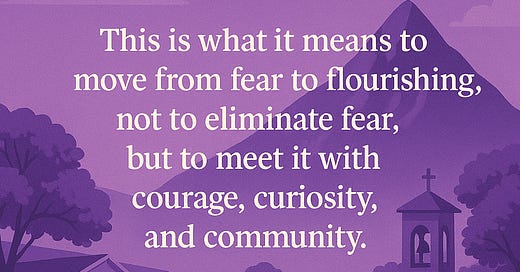A deficit mindset doesn’t serve our community. Here’s what we’re doing instead.
Across higher education, the dominant narrative around AI adoption often centers on fear. Faculty are portrayed as hesitant, resistant, or unprepared. This deficit mindset is not only inaccurate, it’s unhelpful. We are intentionally choosing a different path at Lipscomb. Our goal is to flip the narrative from fear to flourishing.
Instead of assuming that faculty need fixing, we begin with the belief that they bring wisdom, creativity, and deep care for students. As bell hooks (1994) reminds us, “engaged pedagogy does not seek simply to empower students... teachers grow and are empowered by the process” (p. 21). Or, as Lipscomb faculty member Dr. Brandi Kellett said in one of our faculty trainings this week, “Remember, we as faculty are a part of the community of learners in the classroom.” It’s not just our students who grow and learn, we do too! Our role as academic leaders is not to impose change on faculty and students, but to make room for reflection, experimentation, and growth.
One of the key ideas we have been talking about at Lipscomb is the concept of the Unmade Future, as Ed Catmull would say, or the Third Horizon, where we create new possibilities, ideas we haven’t yet imagined (Board of Innovation, n.d.). Catmull (2014) puts it this way, “As we forge ahead, while we imagine what might be, we must rely on our guiding principles, our intentions, and our goals - not being able to see and react to what’s coming before it happens” (p. 224). This is that space I mentioned in the post Courage in the Classroom, where we linger together between the known and unknown, hopefully without panicking!
In Spring 2025, we launched our Faculty AI Design Lab, where educators design and test AI-integrated assignments. The lab is structured around what our AI Fellow, Sarah Gibson, and our Center for Teaching and Learning leaders, Dr. Laura Morrow and Dr. Adam Wilson, call the “Flip the Script” moment. This moment is a critical turning point when faculty move from reaction to reimagination.
This process reflects what our CTL team calls the roadmap from restrictive thinking to transformative thinking about AI. We have to know that our faculty may first have misunderstandings about AI, and we must be aware of a deeper truth: many teachers experience grief or anxiety about AI, especially when its use feels disconnected from their identity as teachers. When we treat that discomfort not as a weakness but as a sign of integrity, we open space for transformation.
In our work, faculty moved from the question "Will I be replaced?" to "How might AI help my students think more deeply?" We give teachers a chance to reframe their identity from someone who performs as a teacher to someone who produces and nurtures learning.
In our sessions, faculty found that co-creating new assignments and assessment methods helped them reclaim agency and insight into their goals for student learning. The key question being: What is the best way to understand what my students know? Maybe it’s not the assessment methods I’ve used in the past, but something entirely new. Embracing this sense of wonder and an orientation toward the unmade future opens up new possibilities.
And in conversations, we’ve heard faculty say things like: “This makes me curious again.” By learning in community, faculty are able to share their explorations with one another, creating their own community of learning where they can hone and improve their use of AI and their craft of teaching.
Parker Palmer (1998) wrote that “good teaching comes from the identity and integrity of the teacher” (p. 10). And nurturing that identity during times of disruption is critical. In over twenty years in higher education, as both a full-time faculty member and someone who serves faculty in leadership, I have seen that faculty growth is nurtured not just through training sessions, but also through mentoring, storytelling, and collective reflection. Leaders must intentionally create time and space for faculty to come together in community to experience these moments.
It is our goal to build those opportunities at Lipscomb. One of the most powerful shifts we’ve seen is when faculty view themselves not as subjects of AI policy or practice, but as co-creators of a new learning culture.
This is what it means to move from fear to flourishing, not to eliminate fear, but to meet it with courage, curiosity, and community.
References
Board of Innovation. (n.d.). What is the 3 horizons model & how can you use it? Board of Innovation. https://www.boardofinnovation.com/blog/what-is-the-3-horizons-model-how-can-you-use-it/
Catmull, E., & Wallace, A. (2014). Creativity, Inc.: Overcoming the unseen forces that stand in the way of true inspiration. Random House.
hooks, b. (1994). Teaching to transgress: Education as the practice of freedom. Routledge.
Palmer, P. J. (1998). The courage to teach: Exploring the inner landscape of a teacher’s life. Jossey-Bass.




